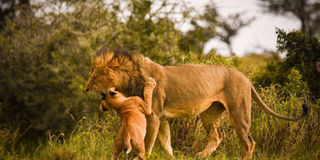Steep decline in lion numbers worries wildlife players

Lions at the Olare Mara. Kenya Wildlife Service announced in February the country was losing at least 100 lions every year. FILE | NATION MEDIA GROUP
One century ago there were 200,000 lions. Today, there are approximately just over 20,000, a landmark lion conservation report said on Saturday.
According to the report, the king of the jungle that once roamed Europe to the southern tip of Africa and West Africa all the way to India, has today been restricted to just eight per cent of their historic range. With current populations now restricted to pockets of Sub-Saharan Africa and a small population in Northern India.
In Africa, where most of the world’s last lion population still survives things are not well for the species. Populations are collapsing fast and lions have already disappeared from many African countries.
Kenya is one of the last countries where lions still reside in the wild. But things are far from rosy here either. The Kenya Wildlife Service announced in February the country was losing at least 100 lions every year.
DIMINISHING HABITATS
Yet, Kenya’s population is estimated to stand at less than 2,000 cats.
In West Africa, the species is currently classified as “Critically Endangered by the International Union for Conservation of Nature (IUCN), a global organisation working towards conservation and sustainable use of natural resources. Overall, within Africa, the species, has suffered a steep decline in both numbers and habitat, and in the last 25 years, lion numbers have declined by half and the decline continues.
Southern and East African lions are listed as being “vulnerable” on the IUCN Red List.
In a stark warning that hopes to stimulate new levels of financial commitment by African countries, the new report, The New Lion Economy: Unlocking the value of lions and their landscapes, that highlights challenges facing the species including diminishing habitats and human-lion conflict, cautions: “Given this drastic loss, African states must work to restore the health of their landscapes and reduce the cost borne by communities when living with lions so that they can support their protection.”
The new report from Equilibrium Research, commissioned by the Lion Recovery Fund (LRF) for World Lion Day 2019, held August 10 annually, says lion survival depends on Africa yet the continent’s governments focused on building economies and eliminating poverty, have neglected spending on conservation.
The LRF hopes to recover the decimated half of the African lion population of approximately 40,000 by 2050.
SPIKE IN POACHING
The report observes that the fate of lions is largely determined by the actions of resident or nomadic people living alongside them. Habitat loss in protected areas is associated with land-use competition and unrestricted human settlement.
In February, Dr John Waithaka, the director of Africa Protected Areas Congress and co-chair of IUCN, while speaking about the lion population said: “Loss of habitat and biodiversity due to corruption, climate change, poverty, poaching, retaliatory killing and increased human population pose the greatest threat to conservation of wildlife, protected areas and the country’s ecosystem.”
In recent years, there has been a spike in the poaching of lions for their body parts such as skin, claws, teeth and bones. However, the drivers of such poaching and trade are currently poorly understood.
The report enumerates how states can unravel the social economic and environmental value associated with lions and their habitats. Offering evidence of options for managing lions and reducing conflict between them and the people who share their rangelands, to show that conflict is not unavoidable and unresolvable.
WILDLIFE CRIME
The authors call for economic development and investment in ecosystem services to support both lions and humans in rangelands where the remaining cats roam.
Unfortunately, Kenya has never taken a lion census. LRF is funding Kenya Wildlife Trust to implement a national survey of northern Kenya, where the least is known about the status and distribution of lions. This survey will help in conservation planning to protect key populations of lions.
“The Olkiramatian and Shompole Group Ranches of Kenya’s South Rift region retain traditional methods of pastoralist livestock husbandry and demonstrate how to create a financially viable model of coexistence with carnivores outside of protected areas,” notes the report
The conservationists link the proliferation of the species to the greater well-being of general wildlife and essential ecosystem services and point to a missed opportunity in the connection of wildlife to the socio-economic gains.
“(In spite of) many leaders seeing destruction of the environment and wildlife crime as an existential threat, they don’t relate it to their national economic ambitions,” notes Chief Executive Officer African Wildlife Foundation, Kaddu Kiwe Sebunya.
He said lions will not survive the 21st century on goodwill alone. Nor will they survive if “reduced to being merely the centrepiece of a high status vacation for foreign visitors to the continent, or even the target of trophy hunters”.


